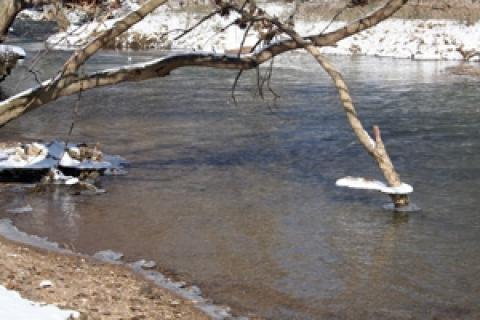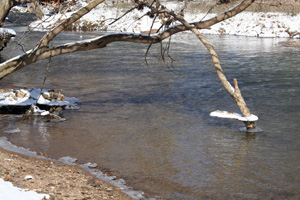
 The air bubbles moving under the clear ice covering the creek's edge, lured the young girl to have a closer look. She squatted and leaned her face toward the icy creek edge. She asked her mom to come take a look at the underwater show of moving, but trapped bubbles and colorful stones lying on the creek bottom. While squatted, the girl scooted out on the ice like a frog sneaking up on a bug. Her mother now stood near her, informing her to get off of the ice. Crack. Splash. It was too late. The ice was not thick enough to support even a 40-pound kid. The mother grabbed her daughter's hood and pulled her from the ankle deep creek. Not likely a drowning situation, but a cold and uncomfortable lesson that cut the family hike short.
The air bubbles moving under the clear ice covering the creek's edge, lured the young girl to have a closer look. She squatted and leaned her face toward the icy creek edge. She asked her mom to come take a look at the underwater show of moving, but trapped bubbles and colorful stones lying on the creek bottom. While squatted, the girl scooted out on the ice like a frog sneaking up on a bug. Her mother now stood near her, informing her to get off of the ice. Crack. Splash. It was too late. The ice was not thick enough to support even a 40-pound kid. The mother grabbed her daughter's hood and pulled her from the ankle deep creek. Not likely a drowning situation, but a cold and uncomfortable lesson that cut the family hike short.
Cold-weather hiking provides various seasonal attractions, such as trekking through winter scenes that are pleasant to the eye and other senses. But some of those natural attractions — ice covered waterways — can go from beauty to beast if not respected. Ice safety is a constant issue for winter anglers, but hikers should keep it in check as well. Many trails skirt along lakes, creeks and rivers, and all add to hiking entertainment. During winter months, it's wise to re-think creek crossings. Tip-toe fordings in frigid streams are tricky with icy rocks as obstacles. If crossing via log bridge or such, a trekking pole in each hand will improve the odds of a dry crossing.
Another dangerous situation results when a hiker considers crossing an ice covered lake as a shortcut. The temps drop and the hike quickly becomes more than what the hiker planned for, so shortcut plans soon build. Crossing over frozen lakes always takes careful planning or simply abandoning the crossing if poking a test hole proves the ice is less than four inches thick (which is acceptable for supporting an average adult). Rivers that appear to be ice capped, should always be avoided. Reason is, rivers are created by land-cutting currents, currents that keep ice thin over top of them.
Even if ice covered waterways are not completely crossed, plunging into the water edges can cut the hike short. Or even worse, cause enough of a foot soaking to instigate hypothermia. Hypothermia slows a human down to the point of no return. Earlier this winter, an Ohio man went for an evening hike during nearly zero degrees. He walked out on a lake, fell through thin ice, crawled back up onto the ice, but froze to death before he could walk back home. It can happen to anyone at any moment. Be safe, enjoy the winter hiking season, and respect the natural attractions.
- 2217 views

